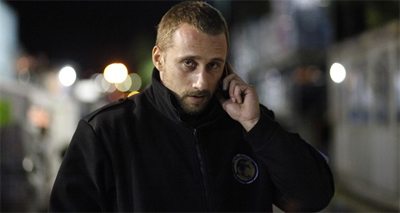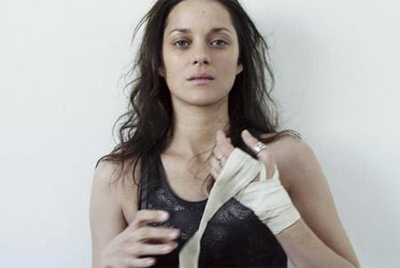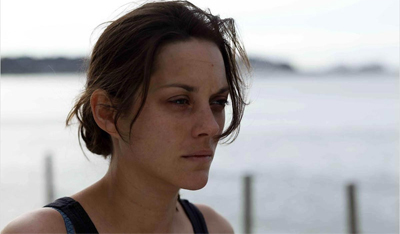Rust and Bone feels a bit… lazy, for lack of a better word. It feels like the product of a writer and director with a huge amount of talent, but no real ambition or enthusiasm. The film features two superb leading performances from Marion Cotillard and Matthias Schoenaerts, but they’re trapped in a film that never seems too bothered. Writer and director Jacques Audiard mistakes trite melodrama for brutal honest, and seems to give up on the film in the third act. It’s a shame, because there’s some solid stuff here, but the whole is much less impressive than the sum of its parts.
Note: This review contains spoilers for the third act of the film. I’ve tried not to give away specific plot points, and to talk in the most general of terms, but I do discuss the ending. Consider yourself warned.
Rust and Bone is a sotry about pain and suffering, and how the injuries we endure define and sometimes strengthen us. Although Marion Cotillard gets top-billing playing whale trainer Stéphanie, it’s Matthias Schoenaerts who carries the narrative drive of the film as failed father, brother, friend and generally human being Alain van Versch. Focusing on the separate pain that Stéphanie and Schoenaerts endure, Rust and Bone positions itself as the story of Alain’s redemption – a long, struggling fight to become more than what he is.
The problem, then, is that for redemption to mean anything, it must be earned. If you want an audience to engage with a protagonist’s journey from a failure to a success, whether personally, romantically or professionally, the transition needs to be earned in order to be worth the price of admission. That’s true of any story in any format. In the blockbuster The Dark Knight Rises, Bruce Wayne pulls himself out of the darkness by deciding that he wants to live, literally hoisting himself out of the pit. In the smaller film The Descendants, failed father Matt King manages to reconnect with his kids despite the fact he’s been emotionally absent.
To be fair, a movie doesn’t have to feature a redemption. There’s something tragic about a character who is either unable or unwilling to seek redemption. Steve McQueen’s superb Shame teases the idea that Brandon hasn’t learned anything from his experiences, and that he simply can’t escape his addictions and habits despite his best efforts. Shadow Dancer suggests that violence is self-perpetuating, despite the best efforts of those involved. Avoiding redemption can give a story a sense of tragedy or power.
However, Rust and Bone foists a last-minute redemption on Alain that feels entirely cheap and entirely unearned, reducing the rest of the film to nothing but pointless nonsense. Throughout Rust and Bone, Alain is a bad parent. He skirts the line somewhere between merely negligent and outright abusive. The film does try to portray him as sympathetic early on, when it’s pointed out that at least he’s a better parent than the boy’s mother. (“They used the boy to smuggle drugs,” Alain explains to his sister.) It’s a pretty low standard to pass, but the movie gives him that. Had the boy’s mother died and left him to Alain, he’d seem much less sympathetic, but at least he’s established as the betterof the two parents.
Throughout the film, Alain is too busy indulging in his animal instincts to pay that much attention to his son. He’s too busy watching fighting on the computer to mind his boy for ten minutes. (Although, to be fair, he’s also interrupted by a phone call.) He’s too busy hooking up at the gym to remember to pick up the kid from school. (“This is the third time in two weeks,” we’re told, suggesting a pattern of negligence.) Just in case we don’t quite register that Alain is not a good father, his son repeatedly references how (physically) cold he is.
However, Rust and Bone wants us to believe in the redemption of Alain, even if it’s too lazy to actually redeem him itself. So, with the movie rapidly approaching the end credits, it conspires to create a situation where it can plausibly claim that Alain had an epiphany. Without going into too much detail, Alain manages another parental screw-up, but manages to avoid the worst possible outcome of that screw-up. As a result of barely foiling his own best efforts to surpass the boy’s mother’s failure as a parent, the film asks to cheer him on.
And there’s no ambiguity here. There’s no sense that the cycle of neglect and indifference continues past this point. Alain isn’t only redeemed by the fact he didn’t mess up as badly as he could possibly mess up. No, this experience somehow transforms Alain into the success that he always could have been. It feels cheap, because there’s no conscious effort made by Alain. There’s no sacrifice on his part. He does take positive steps to mitigate his screw-up, but he’d have to be a truly despicable human being not to. The film doesn’t manage to convince us that Alain is redeemed, merely that he isn’t a complete monster.
If it wasn’t for the tacked on epilogue affirming that, yes, what you’ve witnessed is a happy ending, I would have consider Rust and Bone to be an exploration of the systemic failures of the French Welfare system. Certainly there’s some stuff here to support that reading, as the film glistens with contempt for the establishment. Discovering her brother has been installing illegal monitoring devices for his employer, his sister demands, “Whose side are you on? Theirs?”
It’s plausible to believe that Audiard holds the system in as much contempt as he holds the executives in their nice suits, and that Rust and Bone is really the story of a tragic welfare case that managed to skip past social services due to disinterest and apathy. Sadly, the final scene makes it clear that this is actually meant to be a happy ending. The gap between the climax and the happy ending glosses over the most important part of the story – the part where Alain actually changes as a character.
Of course, the ending is just the biggest expression of a central flaw with Rust and Bone. There’s a sense that it’s a collection of ideas and concepts, but not anything that Audiard could be bothered structuring. Things happen! And then more things happen! But they don’t flow from one to another. Alain strikes up a friendship with Stéphanie. The two have a good time. She finds herself attracted to him. They hook up. An inevitable romantic misunderstanding occurs, where it’s clear that she wants more than he does.
Ignoring, for a moment, the convenience of that plot beat – a staple of the most tired of romantic comedies – the film lacks follow-through. She confronts him about this, suggesting that they need to act like more than just animals towards one another, that they need more. This, of course, goes over his head. He makes an insensitive response and she storms off, shocked by his complete lack of empathy or emotional intelligence. However, within five minutes, the two characters are reunited as if nothing has happened. (To be fair, we’re told that one asked for the other – but no sign of apology, no hesitation, no sense of growth.) There’s no reference to the conversation, no sign that either party has developed their understanding of the other. It just sort of is, because the movie needs the two of them interacting to get through the next plot point.
As such, nothing in the film carries any emotional weight, which makes it very tough to care about any of the characters involved. That’s a shame, because there are two superb central performances from Marion Cotillard and Matthias Schoenaerts. Cotillard makes a convincingly damaged Stéphanie, a character who seems far more interesting and complex than Alain – despite, or perhaps because, the film is less concerned with her than with Alain. Schoenearts does his best to develop Alain as a character, and it’s to his credit that Alain remains interesting despite being a collection of failed father clichés. The pair work well together.
Audiard, to be fair, also has a beautiful eye, and the film does look quite lovely. The scenes of the whales performing tricks for the audience are rendered in stunning slow motion, although they do suffer slightly from looking a bit like an advertisement for Sky HD. A short, dialogue-less scene with Stéphanie and an orca in an aquarium looks absolutely beautiful. Indeed, most of the film does a lot better when the characters aren’t talking – short vignettes featuring the leads in isolation from one another. However, the scenes between the character fall quite flat despite the charm of the leads, and Audiard struggles to convince us to invest in any part of the film.
Rust and Bone is disappointing. Despite two great performances and Audiard’s keen eye, it feels like it can’t be bothered to care too much about its central character. So why should we?
Filed under: Non-Review Reviews | Tagged: Alain, Bone, Dark Knight Rises, film, Jacques Audiard, marion cotillard, Matthias Schoenaerts, Movie, non-review review, review, Rust, rust and bone, steve mcqueen |



























Absolutely agree. The characters are paper thin and the whole movie is superficial. It’s possibly the most throwaway portrayal of a disability I’ve ever seen. Did anyone else notice how, despite taking a constant battering throughout the film, Schoenarts never displays any bruises apart from that one strategic scar on his nose?
Thank goodness. I was beginning to worry that I was alone in my opinion!
It’s OK to be alone! LOL! Thanks for this. I’ll probably get sucked in anyway.
Thanks. I do hope you enjoy, though, for what it’s worth.